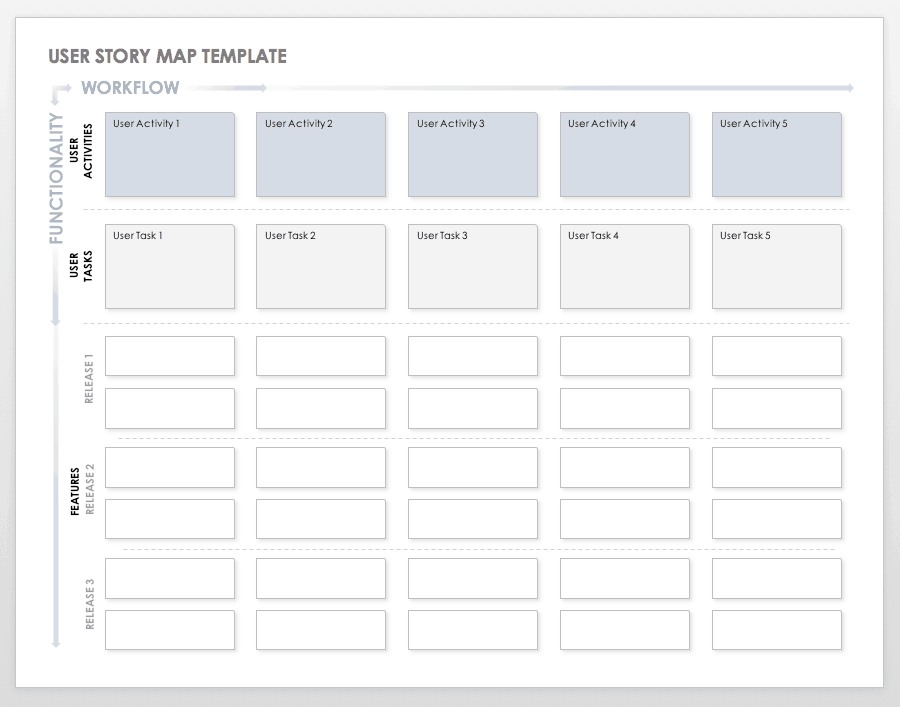What Is User Story Mapping?
User story mapping was first defined for Agile and Lean development in 2005 and is discussed in Jeff Patton’s book User Story Mapping. The “dead simple idea” enables a team or organization to visualize the product from the user’s perspective. User stories represent the customer’s experience as they navigate your product. These user stories provide context to features that are either new or in need of enhancement. As these features are approved for development, they are added to the product backlog and prioritized.
A common complaint regarding product backlogs is that developers and product managers lose sight of the big picture. User stories offer a dynamic and useful visual presentation of typical customer use case scenarios.
User Story Mapping Best Practices
The format of user story mapping depends on the structure of each business and team, but it often begins by bringing a team of subject matter experts (SMEs) together in a conference room and providing them with basic tools: paper, markers, a whiteboard, Post-its, and a camera. Teams can use these tools to note information about users, features, or process steps.
The first step invites everyone to participate and role play. It’s essential to identify the users, their problems, and how they interact with the product. Participants who interact with customers offer great value to this process.
A simple script can be used to articulate a user story: “As a (user of this), can I (do an action), so that I can (have a benefit)?”
This script could read like this: “As a credit card customer, can I go online and schedule a payment, so I won’t be late?”
Post-its in different colors can help show step-by-step processes with supporting activities. Once the teams have developed user stories, Post-its can be grouped into logical sprints with timelines and release estimates.
The highly visual nature of this exercise brings the backlog into full display and can illuminate problems, inconsistencies in planning, bottlenecks, gaps, out-of-scope features, alternative solutions, and risks. This allows the team to subsequently plan their execution.
Some best practices for user story mapping include the following:
- Provide tools that aid in the visualization process: markers, whiteboards, Post-it notes, stickers (dots and stars to highlight important details).
- Include customer representatives who can tell the stories from the customer perspective.
- Use wireframes to support stories.
- Include the who, what, and when in each user story.
- Make each user story specific enough to be coded in a single iteration.
Click here for a sample user story map used by Shandil and his team.
The X/Y-Axis: Where Designers and Developers Collaborate
A user story map can be presented in different forms, but most often is represented in a dynamic visual that contains an x-axis and a y-axis. The horizontal axis (x) contains the sequential order of activities a user experiences as they utilize a system. The vertical axis (y) represents increasing sophistication of the functionality. The first row will contain the most basic functionality, and subsequent rows become more complex.
You can use the template below to map a user story. This is a sample template that you can complete in Microsoft Word, or recreate using Post-it notes on a wall. The number of boxes may vary based on the activities that take place while using a particular system.
Download Template in Word
Try Smartsheet Template
Below is a sample x/y diagram with the MVP highlighted in gold.
The Real Agile and Lean Work Can Begin When the Map Is Complete
Once the big picture is set, it is useful to “walk the map” with the designers, developers, and interested stakeholders. If users are available for this exercise, the results will align with their actual experience. In this process, the team reviews the user story map in an effort to fill holes or identify forgotten elements, with the goal of creating a stronger product.
When the map is complete, it’s time for sprint and iteration planning. This is where the team uses the language and practices of Agile, Lean, and Scrum to define timelines and put the project in motion by developing and assigning epics, backlogs, and tasks.
User Story Mapping Simplifies Agile and Lean Methodologies
User story mapping supports the Agile and Lean development methodologies. Agile depends on small increments of work and quick delivery. User story mapping enables this iterative approach by creating a backlog of features that can be grouped together and prioritized.
The Challenge of User Story Mapping: Keeping Focus
Understanding the customer and their needs takes research and empathy. This can present challenges and may disrupt or change initial team planning or expectations. You should do research as close to the customer experience as possible. Surveys and interviews are always useful. Customer service technicians, sales representatives, and UX designers may have more experience walking in the shoes of their customer and can aid in discovery.
Below are some common challenges of user story mapping:
- Lack of clarity: Knowing your target customer and the problem your solution solves (or intends to solve) is essential prior to beginning the user story mapping process.
- Team location: Planning, meeting, and communication challenges can arise if teams are in different locations and unable to work in person.
- Documentation: In some cases, initial team conversations on what to include may not be properly documented or ranked for importance. In addition, whiteboards and sticky notes can get lost if they are not documented. Creating the backlog can feel like redundant work and become a disparate pile of stories, increasing the difficulty of making sense of the project.
- Focus: Stories may focus on features for reasons other than user acceptance or need. What the end user deems imperative may get lost in this sea of backlogs and never make an appearance in the product or be assigned as a backlog for a later version.
Top User Story Mapping Tools
User story mapping began as an offline exercise that takes simple office supplies and teamwork to create a story that helps prioritize product development projects. But with teams working in different locations or on numerous projects, it may be time to take the map off the conference room wall and place it online. Software tools can ease communication across the building or around the world. The question to use free or paid solutions, as with all tools, depends upon the size, scope, and complexity of the projects. Several tools are available from vendors, such as cloud-based StoriesOnBoard and FeatureMap, Rally by CA, Jira, and the open-source Scrum solution, KADOS.
One of the primary goals of user story mapping is to take the individual stories and build a highly functional and useful customer-centric product. There will always be backlogs and incremental releases, but those who focus on valued features enjoy greater adoption, which, in turn, leads to a higher return on investment (ROI). User story mapping also provides a logical bridge for the often-competing concerns of software designers and those who develop the end product. As Patton says, “The model we’ve built can give you a better picture of your software’s features and help your organization construct the most useful and coherent early release possible.”
Create a Better User Experience with Smartsheet for Software Development
Empower your people to go above and beyond with a flexible platform designed to match the needs of your team — and adapt as those needs change.
The Smartsheet platform makes it easy to plan, capture, manage, and report on work from anywhere, helping your team be more effective and get more done. Report on key metrics and get real-time visibility into work as it happens with roll-up reports, dashboards, and automated workflows built to keep your team connected and informed.
When teams have clarity into the work getting done, there’s no telling how much more they can accomplish in the same amount of time. Try Smartsheet for free, today.


